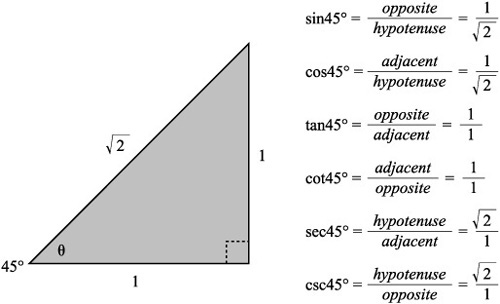Ratios and Degrees
Generating values for the geometric ratios usually involves either knowing the lengths of three sides of a right triangle or calculating this information using the information available to you. As discussed previously, the most common starting position for using the ratios involves employing the Pythagorean theorem to calculate the length of the hypotenuse. If you know the length of the hypotenuse and the lengths of the two sides, then you can proceed to calculate any of the values made available to you through the trigonometric ratios.
To extend this notion, consider a right triangle that possesses adjacent and opposite sides that are 1 unit in length. Figure 12.10 illustrates such a triangle. Given this version of a right triangle, you can then readily substitute the values the triangle provides. For the sine and cosine values, the approximate value of is ![]() 0.707. For the secant and cosecant values, the approximate value of is
0.707. For the secant and cosecant values, the approximate value of is ![]() 1.414.
1.414.
Figure 12.10. Set the sides to 1 to calculate basic values.

The important feature of such calculations is that they enable to you familiarize yourself with a basic way to generate values for different types of angles. Some angles appear often in trigonometric operations. Among these are 30 and 60 degrees.
Figure 12.11 illustrates an equilateral triangle. The significance of an equilateral triangle, among other things, rests in the fact that you can create such a triangle by joining the adjacent sides of two right triangles, as Figure 12.11 shows. If the length of the opposite side of the right triangles is 1 and the hypotenuse is 2, then you can employ the Pythagorean theorem to calculate values to use in the trigonometric ratios.
Figure 12.11. Calculate the value of the adjacent side.

If you apply the Pythagorean theorem to slightly modified versions of the triangle Figure 12.10 illustrates, you can readily arrive at the trigonometric ratios for two other angles that prove important. These are the values that correspond to 30° and 60°. Table 12.3 lists the calculations that result when you the apply the trigonometric ratios to the information Figure 12.11 provides using an equilateral triangle.
Note
When working with the values shown in Table 12.3, it is common to manipulate the resulting quotients so that radicals do not appear in the denominators. To eliminate the radical, you multiply by 1 using the value given by the square root. Here are a few examples:


